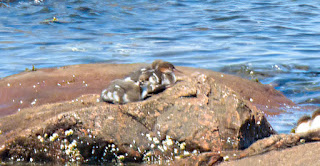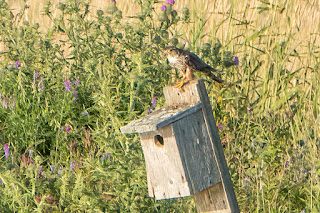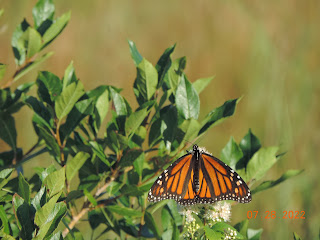July 29, 2022 (Friday)
To respond by e-mail, please address your message to the information line editor, nelsonpoirier435@gmail.com .
Please advise the editor at nelsonpoirier435@gmail.com if any errors are noted in wording or photo
labelling.
For
more information on Nature Moncton, check the website at www.naturemoncton.com
Edited by: Nelson Poirier nelsonpoirier435@gmail.com
**Roger LeBlanc comments he sat in on the tutorial for this weekend’s Monarch Butterfly blitz and recommends it before this coming Sunday's outing, the description of which will be repeated in detail again tomorrow morning.
Roger suggests if you missed the online tutorial and want to know more about the Mission Monarch project you can find all the information on the web site of the original instigator, the Montreal Insectarium at https://www.mission-monarch.org/?mc_cid=c5bda006d7&mc_eid=6a4902860a
Also, as Monarch Butterfly eggs can be quite small, if you have a magnifying glass bring it along. If not and you do have a pair of binoculars bring that and Roger will show you how to use those for the same purpose.
** As reported a few days ago, Jamie
Burris placed several Monarch Butterfly caterpillars into a terrarium with
milkweed plants to let them go out. Jamie reports they have their first 2 Monarch
Butterfly chrysalides, and 3 more caterpillars are not far behind.
Jamie photographed the beautiful
chrysalis.
**Nelson Poirier stopped by Cape Bimet
on Thursday and photographed the Double-crested Cormorants and some Common
Eiders lounging on the rock ledge. When looking at the photo at home, he noticed some
small birds he did not recognize at first that turned out to be Red-breasted
Merganser chicks which he had never seen lounging on a rock before. As
Nelson was zeroing in on the chicks, he did not notice the adult Red- breasted
Merganser female nearby (green arrow) which Gilles Belliveau’s sharp eyes did to suggest the
identification.
**As was
the case during the previous weeks, Yves Poussart enjoyed the recent Nature
Moncton Wednesday evening walk (July 27), this time at the Tucker
Street Ducks Unlimited impoundment. Once again, the site and the temperature provided
perfect conditions for an interesting visit. A good number of ducks (Black
duck, Gadwall, etc.) and few Canada Geese were present, and
the expected shorebirds were not seen.
A Great
Blue Heron, an American Bittern and a Belted Kingfisher
were seen in flight. A minimum of 3 Northern Harrier were also seen as was the case for a Merlin. American Goldfinch
and several species of sparrows were abundant. Some of the
participants concentrated their observations on specific plants found
along the trail.
**Gordon Rattray joined the Nature Moncton walk at the
DU compound at Tucker Street in Upper Coverdale on Wednesday evening. The
participants were treated to many bird and plant specimens along the
trails. Leader Gordon had a hard time advancing the group as they got
very engaged many times. Gordon photographed a Northern Harrier that
landed in several small trees as it cruised the marsh. This activity seemed
unusual to most.
Plants that Gordon photographed are Bristly Sarsaparilla, and Bull Thistle. Scotch Thistle was considerable in the field. Hedge Bindweed as opposed to Field Bindweed, Ladies Thumb, Steeple Bush and Common Reed (Phragmites australis subsp. Americanus) were also present.
Gordon includes a photo showing that the group was
leaving as the sun was setting.
Gordon also
shares more photos when he returned to the Salisbury Wetlands Park a few days
after the Nature Moncton walk on July 20. It was amazing how much the coots
and grebe chicks had grown in just a few days.
**The Tucker
Street DU impoundment was demonstrated to be a haven for Swamp Sparrows
with males constantly calling last Wednesday night. However, only one male
cooperated (perhaps unwilling) to give the group great but distant
observations. Its head crest was raised and tail constantly flicking so
assumedly the group was too close to a nest for its comfort level. Both Rhonda
Langelaan and Yves Poussart were able to get expressive photos!
**Verica
LeBlanc in Miramichi comments that between July 16 and now, she is starting to see
more varied activity in her garden. She generally has the song birds and
American Goldfinch visiting; however, she says her timing was never right for the hummingbirds
and was awaiting the arrival of the butterflies. Even the bumblebees had been
sparce until a week ago. Then it finally picked up.
Verica was able to photograph a female
Common Whitetail Dragonfly, Virginia Ctenucha Moth, Flower Fly, and a
pleasant surprise on Thursday morning was a freshly minted Monarch
Butterfly.
Verica also has Clouded Sulphur
and Cabbage White Butterflies visiting, as well as two hummingbirds
chasing each other to protect their patch and far too fast to photograph.
**Aldo Dorio is yet another to
enjoy Monarch Butterflies at Hay Island on Thursday. The one
photographed was nectaring on Meadowsweet. Unfortunately, there is no milkweed
at Hay Island. A good project to take on for someone to make sure milkweed
is transplanted/planted at that site.
Aldo also photographed a Red
Fox that appears lean but in good health, so it may be a young-of-the-year
animal.
.
**It’s Friday already and time to review what next week’s night sky may have in store for us courtesy of sky guru Curt Nason.
This
Week’s Sky at a Glance, 2022 July 30 – August 6
After twilight look for orange Antares in the heart of Scorpius. High above the
scorpion is a large house-shaped constellation called Ophiuchus the Serpent
Bearer. If your area isn’t light polluted, you can see two lines of stars
rising up and outward from the bottom of the house. The line on the right is
Serpens Caput and the one on the left is Serpens Cauda. Together they comprise
Serpens the Serpent, the only constellation that is in separate parts. Globular
clusters contain many tens of thousands of stars, and they orbit the centre of
our galaxy, which is in the direction just above the spout of the Sagittarius
Teapot asterism. Therefore, these clusters abound in the
Sagittarius-Scorpius-Ophiuchus region of our sky, and many can be seen in
binoculars as fat, fuzzy stars.
Ophiuchus represents Asclepius from mythology, who became interested in the
healing arts after killing a snake and watching another snake bring it back to
life with a leaf. Asclepius brought many people back from the dead, including
Orion after he was killed by the scorpion. Hades, God of the underworld,
complained to Zeus about a decrease in business so Zeus sent for his pet eagle
to kill Asclepius with a thunderbolt. The constellation of Aquila the Eagle is
east of Serpens Cauda.
This Week in the Solar System
Saturday’s sunrise in Moncton is at 5:59 am and sunset will occur at 8:51 pm,
giving 14 hours, 52 minutes of daylight (6:06 am and 8:54 pm in Saint John).
Next Saturday the Sun will rise at 6:07 am and set at 8:41 pm, giving 14 hours,
34 minutes of daylight (6:14 am and 8:44 pm in Saint John).
Telescope users might see the Lunar X around 3 pm on Thursday, one day before
the Moon is at first quarter. On Wednesday Mercury is to the right of Regulus,
setting 50 minutes after sunset. Saturn is in place for late evening observing,
forming a triangle above the two tail stars of Capricornus the Goat in the
southeast, while Jupiter is claiming attention low in the east. Mars passes two
degrees below Uranus early in the week, and Venus still reigns over the morning
sky rising nearly two hours before sunrise. On mornings this weekend early
risers might catch some shooting stars from the South Delta Aquariid meteor
shower.
Join members of the provincial astronomy club, RASC NB, at the Mount Carleton
Star Party on July 29 – 30. Next Friday at 9 pm public observing returns to the
Irving Nature Park in Saint John.
Questions? Contact Curt Nason at nasonc@nbnet.nb.ca.
Nelson Poirier
Nature Moncton

.jpg)




.%20JULY%2027,%202022,%20GORDON%20RATTRAY.JPG)










.%20JULY%2027,%202022,%20GORDON%20RATTRAY.JPG)
.%20JULY%2027,%202022,%20%20GORDON%20RATTRAY.JPG)
-JULY%2027,%202022.%20YVES%20POUSSART..jpg)


.%20JULY%2027,%202022,%20GORDON%20RATTRAY.JPG)







.%20JULY%2028,%202022.%20VERICA%20LeBLANC.jpg)















